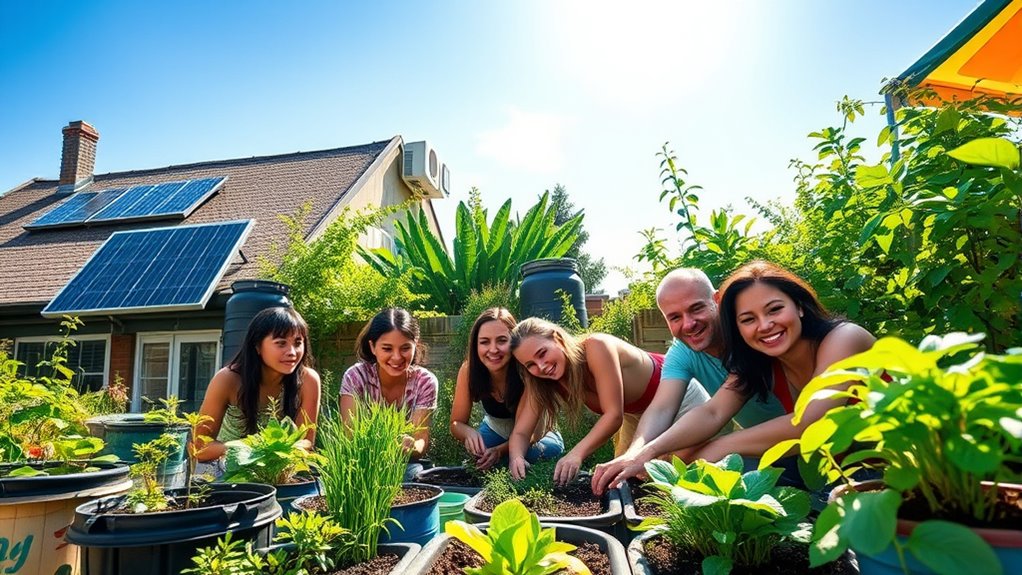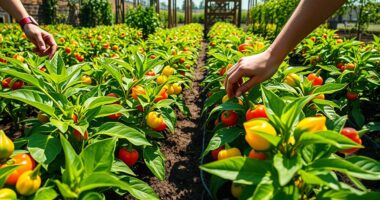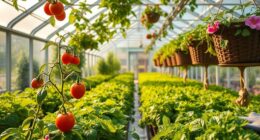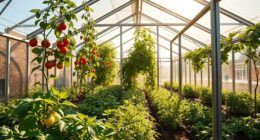If you're looking to create a greener future, I recommend adopting sustainable practices like those in "The Sustainable Sites Handbook" for designing eco-friendly landscapes. Embrace ancient wisdom alongside modern systems for effective sustainability. Try repairing your clothes with "Mending Life" to foster a culture of repair. Explore plant-based recipes from "My Regenerative Kitchen" for healthier meals. Additionally, consider sustainable investing and efficient urban practices. There's so much more to explore on this journey to sustainability!
Key Takeaways
- Implement sustainable landscape design techniques to enhance biodiversity and improve soil health while promoting ecological balance.
- Adopt water management strategies like rainwater harvesting and drip irrigation to conserve water resources and minimize waste.
- Engage in community involvement and education to foster ownership and responsibility for sustainable initiatives, leading to innovative solutions.
- Embrace sustainable fashion practices by mending and repairing clothing to promote a culture of sustainability over consumerism.
- Invest sustainably by prioritizing environmentally and socially responsible practices to achieve long-term economic viability and resource conservation.
The Sustainable Sites Handbook: A Complete Guide to Sustainable Landscapes
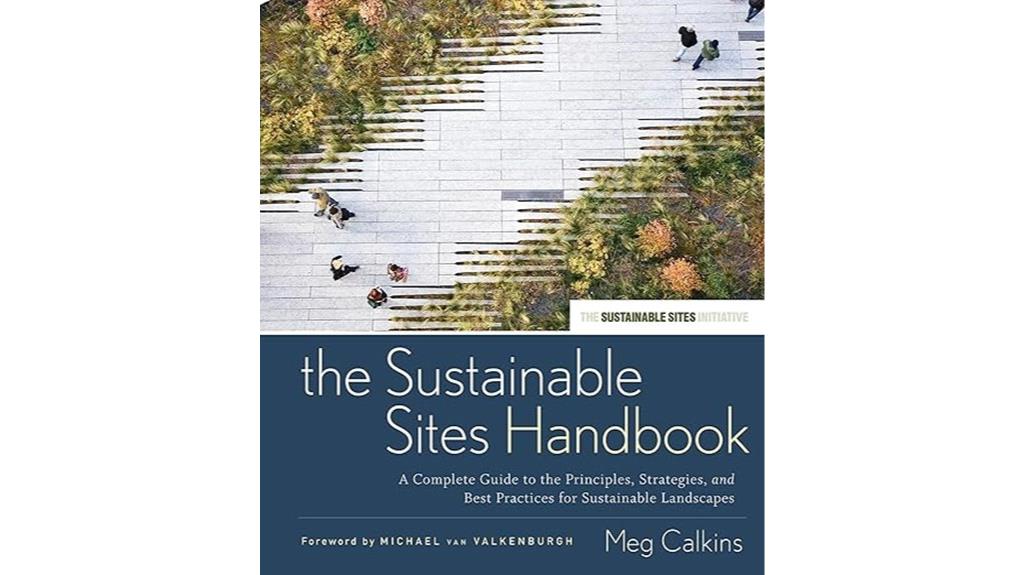
If you're an aspiring landscape architect or a homeowner passionate about sustainable living, "The Sustainable Sites Handbook" is an invaluable resource for you. This extensive guide integrates social, economic, and environmental issues, making it essential for anyone interested in sustainable landscape design. While some criticize the paper quality and grainy images, I found its content thorough and enlightening. The handbook emphasizes the connection between human health and sustainability, presenting principles and strategies that resonate with environmental pioneers. It's a must-read for practitioners and students alike, offering insights that can genuinely transform landscapes and contribute to a greener future.
Best For: Aspiring landscape architects and homeowners passionate about sustainable living.
Pros:
- Comprehensive content covering principles, strategies, and best practices for sustainable landscapes.
- Educational value that serves as a resource for both students and professionals in landscape architecture.
- Emphasis on the connection between human health and sustainability, reflecting modern advancements in the field.
Cons:
- Criticism of paper quality and grainy black-and-white images, which may not meet the expectations for a reference manual.
- Some repetition and typos noted by readers, impacting the overall reading experience.
- Higher price point compared to other resources with better visual presentation.
Ancient Wisdom for a Sustainable World: Blending Ancient Practices With Modern Systems

For those seeking effective solutions to today's pressing environmental challenges, blending ancient wisdom with modern systems offers a powerful strategy. I've been inspired by the Kogi tribe of Colombia, who live in harmony with nature, showcasing how traditional ecological knowledge can guide our actions today. By addressing climate change, deforestation, and biodiversity loss, we can learn from these ancient practices. It's urgent that we listen to Earth's warnings and act collectively. Envisioning a future where these teachings inform modern solutions fosters a holistic approach to sustainability. Let's embrace this wisdom to heal our planet and create a greener world together.
Best For: Individuals and organizations seeking sustainable solutions to environmental challenges through a blend of ancient wisdom and modern practices.
Pros:
- Encourages holistic sustainability: Integrates traditional ecological knowledge with contemporary methods for a more effective approach.
- Addresses critical environmental issues: Focuses on pressing concerns such as climate change, deforestation, and biodiversity loss.
- Promotes collective action: Inspires communities to unite and take action towards healing the planet.
Cons:
- Potential resistance to change: Modern systems may be reluctant to adopt ancient practices due to traditional biases.
- Limited accessibility: Indigenous knowledge may not be easily accessible or understood by all, hindering implementation.
- Cultural appropriation concerns: There may be ethical implications in using indigenous practices without proper respect or understanding.
Mending Life: A Handbook for Repairing Clothes and Hearts

Discovering the art of mending can be a game changer for anyone enthusiastic to embrace sustainable fashion and foster emotional well-being. "Mending Life" by Sonya and Nina offers practical techniques like darning and patching, making it accessible for beginners. The book intertwines personal reflections with hands-on skills, transforming mending into a meaningful act that extends the life of garments. I love how the hand-drawn illustrations add warmth, creating a heartfelt experience. This guide encourages us to nurture both our clothes and relationships, promoting resilience and hope. It's a cherished resource I'll happily pass down, fostering a culture of repair over replacement.
Best For: "Mending Life" is best for individuals interested in sustainable fashion, emotional healing, and hands-on mending practices.
Pros:
- Offers practical and accessible mending techniques suitable for beginners and intermediate seamstresses.
- Combines personal reflections with technical guidance, creating an emotionally resonant reading experience.
- Encourages a culture of repair over replacement, promoting sustainability and resilience.
Cons:
- Some readers may prefer strictly technical instructions without the narrative elements.
- A focus on emotional engagement may not appeal to those solely seeking practical sewing tips.
- The hand-drawn illustrations, while charming, may not suit everyone's aesthetic preferences.
Sacred Actions: Living the Wheel of the Year Through Earth-Centered Sustainable Practices
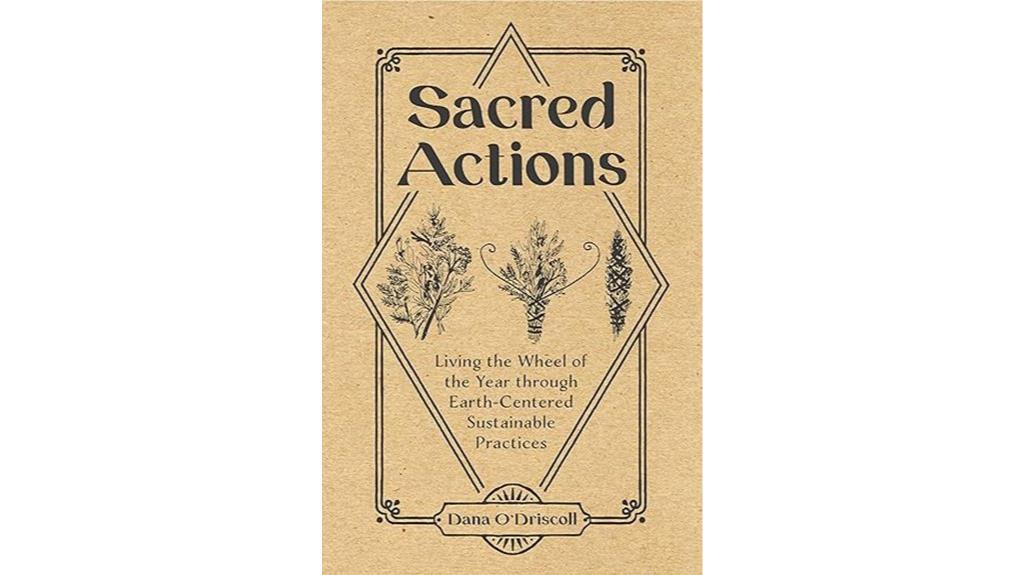
"Sacred Actions" serves as an ideal guide for anyone looking to weave sustainable practices into their everyday life, especially those who feel a deep connection to nature and spirituality. I found Dana O'Driscoll's insights invaluable, as she encourages us to see every action as sacred. With practical applications like composting and creating sacred spaces, I can easily integrate these practices into my routine, regardless of my gardening abilities. The emphasis on community engagement and sharing experiences has sparked meaningful discussions in my circles. This book not only deepens my spiritual connection but also inspires a lasting commitment to sustainability.
Best For: Individuals seeking to integrate sustainable practices into their daily lives while fostering a spiritual connection to nature.
Pros:
- Practical guidance on incorporating eco-friendly practices regardless of gardening experience.
- Encourages community engagement and sharing of experiences, fostering meaningful discussions.
- Deepens spiritual connection to nature, making sustainability feel sacred and personal.
Cons:
- May require a shift in mindset for those unfamiliar with integrating spirituality and sustainability.
- Some practices may be time-consuming or require initial effort to implement effectively.
- Not all readers may find the druidic framework appealing or relevant to their beliefs.
Lean Accounting: Best Practices for Sustainable Integration
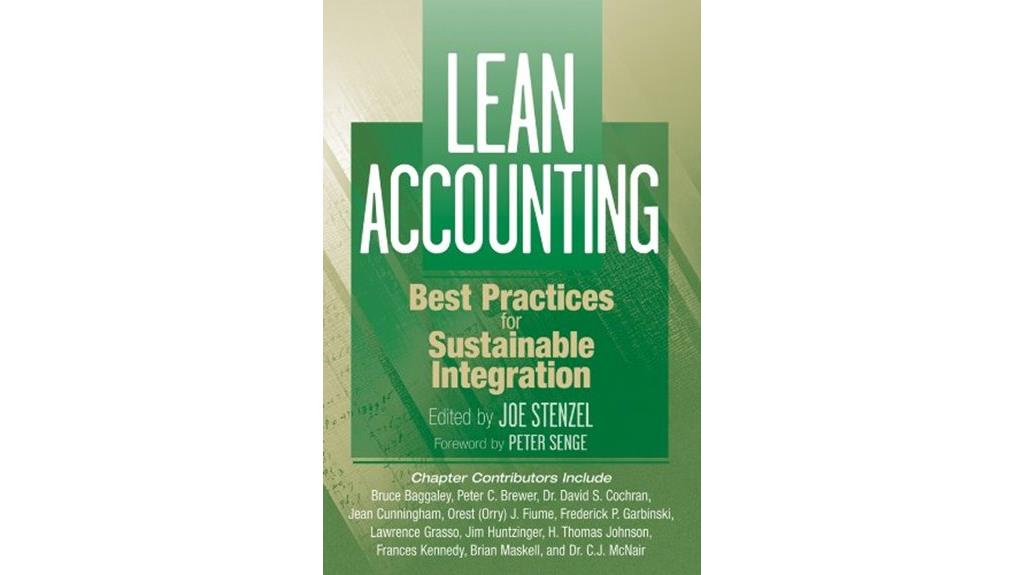
Lean Accounting offers a transformative framework for organizations aiming to integrate sustainable practices into their operations. By focusing on reducing waste and maximizing customer value, it fosters a culture of continuous improvement. I've seen how companies like Toyota exemplify these principles, reshaping their culture and processes for better efficiency. This approach challenges traditional management systems, urging leaders to rethink their effectiveness. Lean Accounting isn't just about numbers; it influences overall strategy and behavior, driving a shift towards value creation. Embracing these best practices can lead to a more sustainable and prosperous future for any organization.
Best For: Organizations seeking to enhance efficiency and foster a culture of continuous improvement through sustainable practices.
Pros:
- Encourages a culture of waste reduction and value maximization, leading to improved operational efficiency.
- Provides a comprehensive framework that influences overall organizational behavior and strategy.
- Supports sustainable management practices that challenge traditional systems, promoting long-term success.
Cons:
- Implementation may require significant changes in existing management structures, which can be met with resistance.
- Initial investment in training and resources might be necessary to embrace Lean principles effectively.
- Not all industries may find Lean Accounting applicable or beneficial, limiting its universal appeal.
My Regenerative Kitchen: Plant-Based Recipes and Sustainable Practices

For anyone looking to nourish both themselves and the planet, "My Regenerative Kitchen: Plant-Based Recipes and Sustainable Practices" is an invaluable resource. The recipes are simple and approachable, making it easy to integrate them into my daily cooking. I've found that dishes like the carrot salad and squash soup not only taste amazing but also promote wellness naturally. The emphasis on sustainable practices alongside these plant-based recipes reinforces my commitment to environmental nourishment. This book has transformed my kitchen into a space where health and sustainability thrive, and I can't recommend it enough for anyone seeking a greener lifestyle.
Best For: Those seeking to incorporate healthy, plant-based meals into their daily cooking while prioritizing sustainability.
Pros:
- Simple and approachable recipes that can be easily integrated into everyday cooking.
- Naturally promotes wellness through its inherently healthy recipes.
- Focus on sustainability emphasizes environmentally friendly practices alongside delicious meals.
Cons:
- May not cater to those who prefer more complex or gourmet recipes.
- Limited options for individuals with specific dietary restrictions not covered in the book.
- Some readers may find the emphasis on sustainability less relevant to their cooking needs.
Sustainable Investing in Practice: ESG Challenges and Opportunities

If you're someone looking to navigate the complexities of sustainable investing, "Sustainable Investing in Practice: ESG Challenges and Opportunities" is an invaluable resource. This book offers practical guidance, making sustainable investing accessible for both novices and seasoned professionals. I appreciate the authors' engaging style, blending humor with insightful analysis of ESG practices. They address the challenges facing retail investors and emphasize the importance of action over words. With straightforward explanations and expert interviews, I found it a thorough read. It's a must-have for anyone enthusiastic to deepen their understanding of sustainable finance and make a meaningful impact.
Best For: Individuals and finance professionals seeking to understand and implement sustainable investing practices effectively.
Pros:
- Engaging writing style that combines humor and insightful analysis, making complex concepts accessible.
- Practical guidance and strategies for integrating sustainability in a multi-asset setting.
- Comprehensive resource with expert interviews and an extensive bibliography for deeper insights.
Cons:
- Some expert interviews may be less engaging than others, impacting the overall reading experience.
- The book may not delve deeply into advanced technicalities, which could leave some experienced readers wanting more.
- Limited discussion on the role of financial institutions in driving sustainability may be seen as a drawback for some.
Cities as Sustainable Ecosystems: Principles and Practices

Cities are increasingly recognized as essential ecosystems that can drive sustainable practices for a greener future. In "Cities as Sustainable Ecosystems," Newman and Jennings offer a framework that aligns urban development with natural processes. They emphasize principles like zero waste, resilience, and self-renewal, which resonate with my own beliefs about sustainability. By integrating cities within bioregions, we can foster locally driven initiatives that reflect our unique environments. While some critiques exist regarding their simplifications, the book's accessible writing and practical strategies provide a solid foundation for educators and practitioners alike. Embracing these concepts can truly transform our urban landscapes.
Best For: Educators and urban planners seeking a comprehensive framework for integrating sustainability principles in city development.
Pros:
- Accessible writing style makes complex concepts understandable for a wide audience.
- Incorporates global best practices and case studies, providing real-world examples of successful urban sustainability initiatives.
- Emphasizes locally driven processes, encouraging community engagement and tailored solutions to environmental challenges.
Cons:
- Rehashes the Melbourne Principles without adding significant new insights or depth to the discussion.
- Oversimplifies the complexities of ecosystems, potentially leading to misunderstandings about natural processes.
- Challenges to the portrayal of indigenous cultures as inherently sustainable may detract from its inclusivity and holistic approach.
Factors to Consider When Choosing Sustainable Practices

When I think about choosing sustainable practices, several key factors come to mind. It's vital to assess the environmental impact, consider economic viability, and guarantee community involvement. Plus, we can't overlook how these practices align with local ecosystems and cultural sensitivities.
Environmental Impact Assessment
As we endeavor for a greener future, understanding the Environmental Impact Assessment (EIA) process is crucial for making informed decisions about sustainable practices. The EIA is a systematic approach that evaluates the potential environmental consequences of projects before they start. It involves identifying possible impacts, evaluating their significance, and developing strategies to mitigate any adverse effects. Public participation is an essential component, allowing stakeholders and communities to voice their concerns. In many countries, legislation mandates EIAs for specific projects, ensuring environmental considerations are integrated early in decision-making. The effectiveness of an EIA is measured by its ability to inform project design and influence decisions, ultimately reducing negative environmental impacts and promoting sustainable practices that benefit us all.
Economic Viability Considerations
Although considering economic viability might seem secondary to environmental concerns, it's essential for the success of sustainable practices. I've found that projects financially feasible are more likely to be implemented and maintained over time. By analyzing the cost-benefit ratio, you can uncover potential long-term savings, like reduced energy consumption and waste disposal costs, making your initiatives more economically resilient. Research shows businesses adopting sustainable methods often reduce operational costs by 10-30%. Plus, investing in these practices can attract funding and incentives, as many governments support environmentally responsible projects. Finally, evaluating market demand for sustainable products is vital; shifts toward eco-friendly options can greatly bolster the economic viability of your sustainability initiatives.
Community Involvement Importance
Community involvement plays an essential role in the success of sustainable practices, ensuring that initiatives resonate with local values and needs. When communities engage in decision-making, they foster a sense of ownership and responsibility, leading to higher participation rates and long-term commitment. I've seen firsthand how collaborating with community members enhances knowledge sharing, empowering individuals with the skills needed to adopt sustainable practices in their daily lives. Furthermore, active involvement often results in improved social cohesion and trust among residents, creating more resilient networks. Community-driven initiatives can also spark innovative solutions, as diverse perspectives contribute to tailored approaches that effectively address local contexts. Ultimately, involving the community is vital for achieving meaningful and lasting sustainability outcomes.
Compatibility With Local Ecosystems
Understanding compatibility with local ecosystems is essential when choosing sustainable practices. I've found that recognizing the native flora and fauna helps guarantee our efforts support rather than disrupt biodiversity. For instance, in arid regions, implementing drought-resistant landscaping aligns perfectly with local climate conditions and boosts resilience. Tapping into indigenous knowledge can offer valuable insights into sustainable land management techniques that have thrived for generations. Additionally, evaluating soil health and native species can guide us toward agricultural practices that maintain ecological balance and enhance soil fertility. Finally, integrating water management strategies that mimic natural hydrological cycles not only sustains local water resources but also prevents erosion and runoff, protecting the ecosystem we depend on.
Cultural Relevance and Sensitivity
Recognizing the importance of compatibility with local ecosystems naturally leads us to contemplate cultural relevance and sensitivity in sustainable practices. I've learned that honoring the traditional knowledge of indigenous communities is essential, as they've managed their environments sustainably for generations. By incorporating local cultural values and customs, we can enhance community engagement and create initiatives that are widely accepted. Understanding a community's historical relationship with the land guides us in developing respectful and beneficial practices. Engaging community members in decision-making guarantees that our sustainability efforts address their specific needs and concerns. Ultimately, using culturally sensitive approaches means our practices resonate with local customs, increasing the likelihood of adoption and long-term success.
Long-term Sustainability Goals
When considering long-term sustainability goals, it is crucial to align them with the principles of environmental stewardship, social equity, and economic viability. I find that setting measurable targets—like reducing carbon emissions, conserving water, and enhancing biodiversity—helps me track progress effectively. Engaging stakeholders during the goal-setting process not only boosts buy-in but also fosters a shared responsibility towards our sustainability targets. I've learned that regularly reviewing and adjusting these goals keeps them relevant amid new scientific findings and societal changes. Finally, integrating sustainability into my organization's mission inspires innovation and cultivates a culture committed to long-term environmental and societal well-being. Together, we can create a more sustainable future by adopting these practices.
Frequently Asked Questions
How Can I Start Implementing Sustainable Practices at Home?
I've found that starting small really helps when implementing sustainable practices at home. I began by reducing plastic use; I swapped to reusable bags and containers. I also set up a compost bin for food scraps, which has made a huge difference. I've started using energy-efficient bulbs and unplugging devices when they're not in use. Each step feels manageable, and I'm excited to see the positive impact on my home and the planet.
What Are Some Affordable Sustainable Options for Beginners?
Did you know that the average person generates about 4.4 pounds of waste each day? It's staggering! When I started my sustainable journey, I found affordable options like using reusable shopping bags and switching to a refillable water bottle. I also began composting kitchen scraps and using energy-efficient light bulbs. Small changes like these not only save money but also make a positive impact on our planet. It's easier than you think!
How Do I Measure My Carbon Footprint Effectively?
To measure my carbon footprint effectively, I start by tracking my daily activities, like transportation, energy use, and waste production. I use online calculators that estimate emissions based on my lifestyle choices. I also keep an eye on my eating habits, as food choices considerably impact my footprint. By reviewing this data regularly, I can identify areas for improvement and make informed decisions to reduce my overall environmental impact.
Are There Certifications for Sustainable Products?
Oh sure, because who doesn't love a good stamp of approval on their eco-friendly yogurt? Seriously though, yes, there are certifications for sustainable products. I've found labels like Fair Trade, USDA Organic, and Energy Star to be quite helpful. They assure me I'm making greener choices. Just remember, not all certifications are created equal, so I always check their credibility before I trust them with my precious dollars.
What Role Do Local Communities Play in Sustainability Efforts?
I believe local communities play an essential role in sustainability efforts. They often identify unique environmental challenges and develop tailored solutions. By working together, community members can share resources, knowledge, and support local initiatives. I've seen firsthand how grassroots movements can inspire change, whether it's through community gardens or recycling programs. When people unite, they create a powerful force for positive impact, fostering a stronger connection to the environment and each other.
Conclusion
By adopting sustainable practices, we can genuinely make a difference for our planet's future. For instance, consider a community that transformed a vacant lot into a thriving urban garden, providing fresh produce and fostering local connections. It's a powerful reminder that even small actions can lead to significant change. Let's commit to integrating these practices into our lives, ensuring a greener, healthier world for generations to come. Together, we can cultivate a sustainable future.
